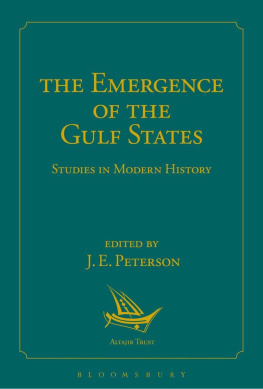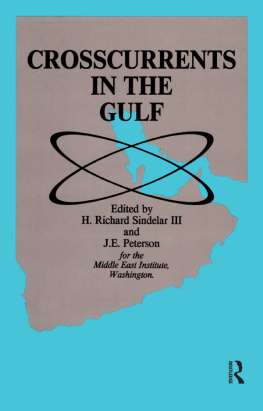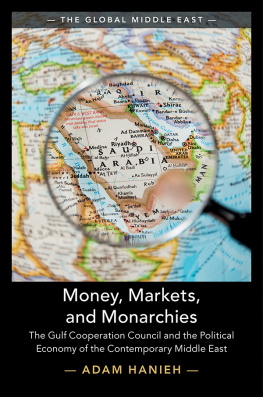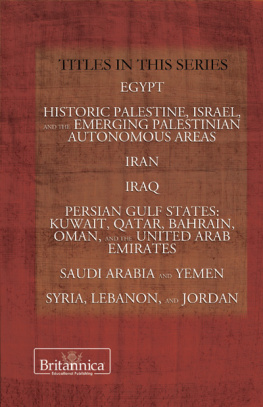Figures
The Jewel of Muscat. A modern reconstruction in Oman of a ninth- century Arab sailing vessel. Photo Miguel Willis. Copyright 2010 Oman Ministry of Foreign Affairs
A View of Lingah from R. Temple (1810), illustrating British naval action against pirates in 1809. Crown Copyright: UK Government Art Collection
Christian and Jewish merchants in Basra (1891). P.H. Hotz, Royal Geographical Society
The mahmal (the camel litter sent along with the Egyptian hajj delegation) passing through Makkah on the way to Arafat (c.1914). Humphrey Bowman Collection GB165-0034 Album 1, Middle East Centre Archive, St Antonys College, Oxford
An Ikhwan member (1923). Major R.E. Cheeseman, Royal Geographical Society
Landing the cable of the Indo-European Telegraph at al-Faw, northern Gulf (1865). Illustrated London News Ltd/Mary Evans
Distant view from the sea of Bushihr (Bushire) on the Iranian coast of the Gulf (1856). Illustrated London News Ltd/Mary Evans
Wind tower in al-Bastakiyyah area of Dubai (1937). Sir Rupert Hay, Royal Geographical Society
Fort al-Jalali, constructed by the Portuguese, and the British consulate in Muscat harbour (1905). Percy Cox, Royal Geographical Society
A durbar held by Lord Curzon, viceroy of India, with the Trucial Shaykhs aboard the RIMS Argonaut off of Sharjah (1903). British Library Board (Persian Gulf) PG 49/1 (7)
Telegraph Island in Elphinstone Inlet of Omans Musandam Peninsula. The name comes from the establishment of a station of the Indo-European Telegraph on the island in 1864. J.E. Peterson
Maritime view of Bombay with a number of East Indiamen in the foreground (c.1750). National Maritime Museum, Greenwich, London
View of the boat harbour in Kuwait as seen from the British Political Agency (1911). W.H.I. Shakespear, 1911, Royal Geographical Society
Pearl dealer in Kuwait (1946). Reproduced from the BP Archive
Suq al-Khamis (Friday market) in al-Hufuf, al-Ahsa (1905). Percy Cox, 1905, Royal Geographical Society
A pearling boat on the Bahrain pearling banks (1926). Sir R. Hay, 1926, Royal Geographical Society
Abdullah al-Sulayman, Saudi Arabias Minister of Finance, and Aramco Vice-President J. MacPherson approving the Saudi Arabian Railways agreement in Dhahran, Saudi Arabia (1947). Saudi Aramco Archives
Gathering of tribal leaders at a majlis of a tribal shaykh, near Kuwait (1911). W.H.I. Shakespear, Royal Geographical Society
Bedouin of the Ajman tribe on the march near Thaj, now in Saudi Arabia (1911). W.H.I. Shakespear, Royal Geographical Society
A reception following the opening of a Quranic school near Nizwa, Oman (1978). Guest house (sablah) etiquette offers a key index of notions of person and social value. Dale F. Eickelman
King Abd al-Aziz and his son Saud returning from prayers on a Friday in Riyadh (1939). Gerald de Gaury, 1939, Royal Geographical Society
Four men and a boy at a coffee hearth inside a house in Bal Qarn tribal territory in Asir (1946). Wilfred Patrick Thesiger, 1946 Pitt Rivers Museum, University of Oxford (Accession Number: 2004.130.6331.1)
Abu Dhabi shaykhs standing outside Qasr al-Husn fort in Abu Dhabi (1948). From left to right, a shaykh from the Naim tribe, Shaykh Hazza ibn Sultan Al Nahayan, Shaykh Shakhbut ibn Sultan Al Nahayan (the ruler of Abu Dhabi), Shaykh Khalid ibn Sultan Al Nahayan, unidentified young man. Wilfred Patrick Thesiger, 1946 Pitt Rivers Museum, University of Oxford (Accession Number: 2004.130.17650.1)
A woman of Hail, now in Saudi Arabia (c.1900). Gertrude Bell Archive, c1913, Newcastle University
Abd al-Aziz Al Saud, later king of Saudi Arabia, and Sir Percy Cox, High Commissioner of Iraq, at the Uqayr conference (1922). H. St. John B. Philby, Philby Collection 16/1235, Middle East Centre Archive, St Antonys College, Oxford
The Bahrain Constituent Assembly in session (1972). M.H. Kamaluddin, Diaries of a Minister
The signing of the agreement ending the treaties of protection between Britain and the Trucial States (1971). Seated (left to right): Sir Geoffrey Arthur (British Political Resident in the Persian Gulf), Shaykh Zayid ibn Sultan Al Nahayan (ruler of Abu Dhabi), Shaykh Rashid ibn Said Al Maktum (ruler of Dubai). Standing behind them on the left are Ahmad ibn Khalifah al-Suwaydi of Abu Dhabi and Mahdi al-Tajir of Dubai. No credit
Sultan Qabus ibn Said Al Bu Saidi on his annual meet the people tour at Shinas on Omans al-Batinah coast (2005). Hamid alQasmi/AP, Ref AP05020802281
Kuwaiti oil riggers during training (1957). Reproduced from the BP Archive
Boy on a camel with the UAE national flag during a parade in Dubai celebrating the UAE National Day (2012). Ahmed Jadallah/Reuters/Corbis, Ref 42-48843653
Maps (between pp. 240241)
From Theatrum Orbis Terrarum by Abraham Ortelius (152898), Antwerp, 1570. British Library Board Maps C.2c.3
The Indian Ocean
The Arabian Peninsula: topography and place names
The Arabian Peninsula: imperial zones of influence and expansion of the First and Second Saudi States
The Arabian Peninsula: boundaries and the expansion of the Third Saudi State
The Gulf: boundaries and oil and gas fields
The Gulf: ports and communications
The United Arab Emirates and boundaries
Tables
The pearling industry in the Gulf, 1907
Gulf trade with India, 1904
Kuwaits retail merchant community, 1904
Merchant groups in Eastern Arabia
Graphs
Percentage share of military spending in GDP, 19882012 average
Annual electricity generation in Saudi Arabia, 196984
Water supply from Saudi desalination plants, 197084
Paved roads in Saudi Arabia
Ratio of government to private consumption in GCC and select international cases
Segmentation of GCC labour markets by sector and nationality














